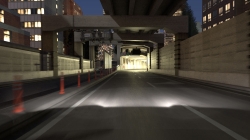Some of the New Products on Show
Sensor perception simulation
rFpro
 rFpro will display a new simulation technology that considerably reduces the industry’s dependence on real-world testing for the development of autonomous vehicles and ADAS. The company’s new ray-tracing rendering solution is the first to accurately simulate how a vehicle’s sensor system perceives the world.
rFpro will display a new simulation technology that considerably reduces the industry’s dependence on real-world testing for the development of autonomous vehicles and ADAS. The company’s new ray-tracing rendering solution is the first to accurately simulate how a vehicle’s sensor system perceives the world.
The ray-tracing engine is a software-in-the-loop (SIL) solution aimed at generating synthetic training data. It uses multiple light rays through the scene to accurately capture all the nuances of the real world. As a multi-path technique, it can reliably simulate the huge number of reflections that happen around a sensor. This is critical to accurately portray reflections and shadows in low-light scenarios or environments where there are multiple light sources.
Modern HDR (high dynamic range) cameras used in the automotive industry capture multiple exposures of varying lengths of time. To simulate this accurately, rFpro has introduced its multi-exposure camera API. This ensures that the simulated images contain accurate blurring, caused by fast vehicle motions or road vibrations, alongside physically modeled rolling shutter effects.
rFpro’s ray tracing is applied to every element in a simulated scene that has been physically modeled to include accurate material properties to create the highest-fidelity images.
Booth 6102

